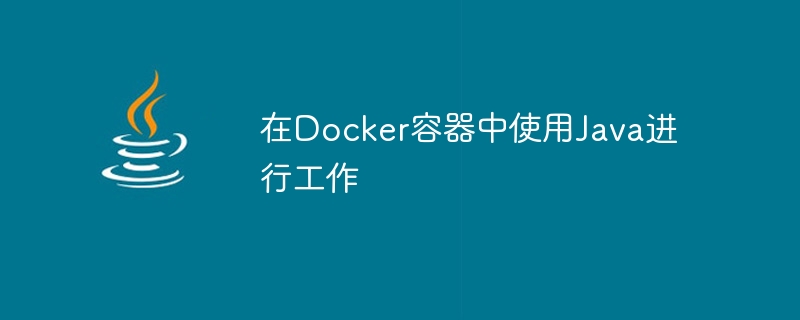Home >Java >javaTutorial >Working with Java in Docker containers
Working with Java in Docker containers
- WBOYWBOYWBOYWBOYWBOYWBOYWBOYWBOYWBOYWBOYWBOYWBOYWBforward
- 2023-08-27 17:21:051371browse

Java is one of the most popular enterprise languages today. It is at the core of object-oriented programming and provides a powerful platform for building enterprise-grade applications and test platforms. For newbies, installing and adapting to a Java environment can take some time initially.
Docker containers allow you to access the Java runtime environment within them, providing an easy-to-manage packaging environment for installed libraries. If you have Docker installed on your local machine, instead of running a Java application and going through all the tedious work, you can easily build a Java image by pulling it directly through the Docker registry and directly in the environment provided by the container Run Java applications in simple and easy steps.
In this article, we will discuss all the steps you need to follow to run a Java application inside a Docker container. There are two main ways to use and run java applications inside Docker containers.
You can create and build custom images and install java using apt-get command by specifying them individually in dockerfile.
You can pull the official Java image directly from the Docker registry and run your Java application directly in it.
We will use the simpler method, the second method. Let's walk through the process step by step.
Create a build context to store your dockerfile and Java application
First, you need to create a docker build context that contains your dockerfile and Java application.
mkdir my−java−app
Creating Java Applications
You can create simple Java applications in files with a .java extension. See the code snippet below, which is stored in a file named "tutorialspoint.java" in the "my−java-app" directory we created in the above step
import java.utils.*;
class Main{
public static void main(String args[]){
System.out.println("Welcome to TutorialsPoint");
}
}Create a Dockerfile to build Mirror
Create a file named "dockerfile". Include the following instructions in a file and save it in the "my−java-app" directory that already contains the java application.
#Pull the Java base image FROM java:8 #Set the working directory WORKDIR /var/www/java #Copy the build context COPY . /var/www/java #Compile the Java application RUN javac tutorialspoint.java #Run the executable CMD ["java", "Hello"]
The dockerfile above specifies all the instructions required to create a java image and run our application inside the Docker container associated with that image. It pulls the Java version 8 image from the Docker registry and sets the working directory. It then copies the Docker build context containing our Java application. It then compiles the java application using the javac command and finally runs the executable file created after compilation using the CMD command.
Building the Docker Image
After creating the dockerfile, you can use it to build your docker image using the following build command.
sudo docker build −t <image−name> .
After executing the above command, it will build the Docker image successfully.
Running Docker Containers
You can now use the Docker run command to create and run your Java application inside a Docker container as shown above.
sudo docker run <image−name>
All in all, creating a perfect Java runtime environment to execute all Java applications can be a daunting task. Thankfully, Docker provides pre-built Java images that you can easily pull from the Docker registry and start building your Java applications right away. You can also extend it to create Spring environments and all other Java enterprise platforms and can handle Java applications at scale. Docker containers provide a contained environment to manage all your applications without having to worry about version control, project management, resource management, and more.
In this article, we discussed how to pull the official Java image registry from Docker, create a Dockerfile to run our Java application, use the Docker build and run commands to build the image, compile and execute app.
The above is the detailed content of Working with Java in Docker containers. For more information, please follow other related articles on the PHP Chinese website!

